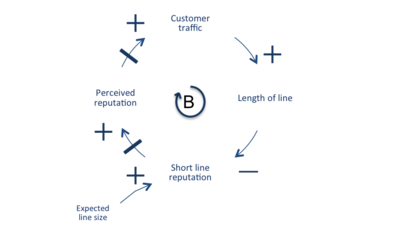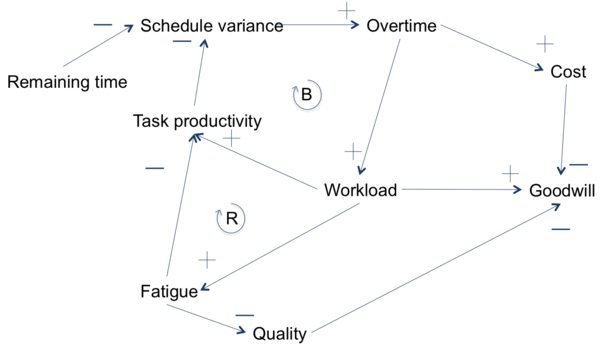Causal Loop Diagram
Developed by Emilie Munk Haagerup
Abstract
To create a CLD a number of interesting variables that is wished to be unfolded according to complexity has to be found. They are linked with arrows displaying their effect on one another. The link has a polarity, which can either be positive or negative. If the link creates a loop, a feedback loop has appeared. The feedback loop can also either be positive or negative. A positive feedback loop is called reinforcing and a negative feedback loop balancing. [1] An example of a feedback loop is shown in the figure to the right.
This tool can be applied in project management, for the project manager to foresee the effects of the process when modelling a project, and later on, to reflect and improve the system. The project manager wishes to reach the goal of the project, taking into consideration key known variables; time, budget, safety and quality, which are the inputs to start developing the CLD. [2] By examination of the dynamics in the CLD, the project managers can use it as a decision tool and be aware of where to place their effort in the complex system to reach the goals.
The tool can be used in all systems, but especially proves beneficial in complex processes, since the project manager cannot frame all the effects and causes intuitively as they interrelate differently. The activity of diagraming the CLD consist of the project manager revising and organising the complexity, and the result should be clarity. But in the situation of a significantly more complex process the diagram can cause confusion to the reader, as numerous feedback loops have to be considered at the same time to base one decision. In these situations there are too many variables/inputs included in the CLD, as the intention is to create clarity. The appropriate number of inputs therefore has to be selected according to what variables are causing problems and what variables should be left out. [3]
Contents |
History
In the effort of handling complex system the system dynamics theory is used. A causal loop diagram is a tool developed later on for a simpler way of portraying the behaviors in the system. It was firstly introduced in the paper; Market Growth as Influenced by Capital Investment from 1968 by Forrest, where the marketing is explained in loops with arrows in between. It was not yet called a causal loop diagram, but it is the basis for creating feedback loops and later on the causal loop diagram. [4]
What is a Causal Loop Diagram?
A Causal Loop Diagram (CLD) maps the complexity and dynamics of a system, which relates to the complexity between variables and not for the variable it self. [5] The system can in regards to project management be the process of the actual project, in regards to the program management be the system of effect chains between the projects and concerning portfolio management be mapping how the system of production affect the different products offered in the portfolio.
The complexity arise when multiple variable affect or depend on one another and create interrelations. The variables are inputs that influence the system and the output is the variables found causing the behavior of the system. The CLD can also be explained as a more complex cause effect tree, where the variable are causes that create effects illustrated by links and polarity.
Links and Polarity
The effects between the variables are indicated with links. The effect of the links can either be positive or negative to the linked variable. The polarity is positive when a variable is increasing or the effect of the first variable will cause an effect in the same direction for the linked variable. The polarity is negative when the variable is decreasing or the effect of the first variable will cause an effect in the opposite direction for the linked variable. [6] A link with a positive polarity does not mean that it is has a good effect to the linked variable, but that it will increase according to the cause variable. This is also applicable for negative polarity, which does not mean a bad effect but that the linked variable will decrease according to the cause variable. [7]
Feedback Loops
The links can go both ways and creates loops in the CLD. The loop is generating feedback to the original variable and this is where the system can map the complexity, as more loops are represented in most CLD. There are two kinds of feedback loops; reinforcing and balancing. [8]
- A reinforcing loop is positive and is created when two or more variables are linked with positive polarity or that the number of negative loops is even. This will create a growth of the variables.
- A balancing loop is negative and is creating a balance between two or more variables as there is an odd number of negative links.
As the figure to the right illustrates, a simple example could be the system of the population size. The variable ‘births’ have a positive link towards the size of the population and the feedback towards births is also positive, as a bigger population creates more mothers and more births. The loop is reinforcing as it generates growth in the size of the population. But the population also has an effect on number of deaths, as the population grows the number of deaths grows, which is a positive effect. But numbers of deaths has a negative effect on the population, which creates the balancing feedback loop as is has en odd number of negative links.
Different Dynamic Behavior
The different dynamic behaviors can be illustrated by the combination of the two kinds of feedback loops. The behavior is also the output of the CLD, as it is what the creator can interpret from the diagram. The fundamental dynamic behaviors are exponential growth, goal seeking and oscillation, which can interact in the common models: overshoot and collapse, S-shaped growth and growth with overshoot. [9] [10]
- Exponential growth is a single or multiple reinforcing feedback loops after each other. An example could be the compound interest rate, where the variables are interest earned and balance of the account. The interest earned results in growth in the balance of the account, which results in more interest earned and so on.
- Goal seeking behavior is created by the combination of one or more balanced feedback loop. The positive and negative effects are trying to create equilibrium at the state of the desired goal.
- Oscillation behavior is the result of a number of balancing loops that is constantly overshooting and undershooting according to the goal. An example for this dynamic behavior could be the case of customer service in a supermarket and is illustrated in the figure to the right. The goal could be a maximum of three customers in line at each cash register. When the variable 'customer traffic’ grows the length of the lines will increase and have a positive link. The longer the length of the line is, the worse will the reputation get and therefore a negative link. The customer will still expect a short line when going to the super market, which has a positive link towards the reputation. This causes a delay in the effect towards the perceived reputation, which then causes a delay in the understanding of the customer traffic. The problem is that the supermarket will not be able to determine how the customer traffic will be at all time and a result is that the number of open cash register will always be either to many or to few in line, which results in an oscillating pattern.
- S-shaped growth is the combination of reinforces and balanced feedback loops. The reinforced feedback loop creates growth to a point where the balanced feedback loop reacts and seeks towards the goal equilibrium. This can also be applicable the other way around, staring with a balanced loop followed by a reinforcing loop. An example would be like the population rate CLD.
- The dynamics of growth with overshoot are the result of exponential growth followed by oscillation behavior.
- In the case of overshoot and collapse the behavior starts as a S-shaped model. The growth continues beyond the point of the start of the balanced loop, which results in an extra variable occurring that will determine the collapse. An example would be overfishing the ocean that results in extinction of species.
The dynamic behaviors helps finding patterns in the systems that seems very complex after the CLD is generated.
How to create a CLD
To create a causal loop diagram two questions are asked; what does this variable affect and how is the effect. The diagram starts with known variables of the system from where the diagram is created by continuously asking the two questions until the boundaries of the system is reached.
Variables
The variables are the starting point of creating the CLD but firstly the creator has to be aware of the system that is to be created. A list of known variables is listed and the effects can then be discussed accordingly. The variable is illustrated by a word or a sentence. [11]
Links and Feedback Loops
From the know inputs in the form of variables, the effect and to what other variables are examined. The effect or the link is illustrated as arrows between the variables. After detecting a link, the effect of the link has to be argued and based on the result marked with its polarity. The polarity is marked as a plus or minus sign at the arrowhead. When a feedback loop is created is has to be determined if it is either balancing or reinforcing by looking at the polarity of the links in the loop. If the feedback loop is balanced it is marked with a circling arrow with a ‘B’ in the middle and a ‘R’ if it is reinforcing. [12]
Analysis of Dynamics Relations
Finally an analysis of the relations in the CLD can illustrate the dynamics of the system by creating behavioral graphs. From the analysis, parts of the CLD can be divided into sections as it has different dynamic behaviors and based on the behavior that the project manager is looking for. The patterns are spotted by investigating how the feedback loops affect one another and a graph can be drawn to illustrate the movement of the system.
CLD in Project Management
CLD can illustrate all kind of systems, which is present in both project, program and portfolio management. The process of a project can be present in all kind of management types, which is why it is relevant to look at how project managers handle system complexity with the use of CLD. The project manager has to foresee and realize the complexity of the process before initiating the development of a CLD to systematically plan a project process. The tool offers for the project manager to:
- Get a better understanding of the dynamics
- Make decisions, based on the unwanted causes and what triggers them
- Finding the root cause for a problem in the system
In project management the system revolves around task completion, as it is the primary goal of the project manager and will in most cases be the starting variable input for creating the CLD.
The variable to use as input in the CLD can either be measurable or intangible. Examples of measurable variables could be time, cost and quality where intangible variables could be goodwill and exhaustion of employees. [13] There cannot be generated one CLD template for all project systems because the important variable to display in the CLD will vary from project to project. It is therefore important to consider what variables should be part of the CLD. The CLD should create some clarity to the project manager, so it is reasonable to only look at the key cause relationships in the system. These are generated by the influential feedback loops, as it is where the boundaries of the CLD should be established. Variables that are not part of feedback loop are not always worth adding as it only causes more confusion.
The key causal relationships are the relationships between the time, cost, quality and safety in most cases. As mentioned before, the variables can vary in importance for different project managers. The tool should be a holistic picture of the system where the key variables are diagrammed according to each other. The task of creating a CLD could seem easier if it was illustrating the key variables individual to a point where a CLD was created for each of them. But it is not creating the holistic picture that the project manager is looking for and this means that the CLD is performing better since one diagram mapping the causes and effects in between. [14]
Application of CLD
The project manager can apply the CLD in more stages of the process. It will be more valuable to form the CLD before the process of the project starts, so the working system is known in advance. Changes can appear during the process where the CLD has to be modified accordingly, as the original perception of the system was insufficient.
For the project manager to create a CLD, the events that are interesting to illustrate in the CLD have to be found. The project manager wishes to add variables from the system focusing on how and where things can go wrong, which could be the interesting events. The CLD is then mapping the consequences of variance in some of the key variables, time, cost, safety and quality. [15]
The dynamic behavior can systematic be analysed from the CLD by looking at the feedback loops creating a pattern. From the patterns the project manager can determine where the behavior is resulting and will be a base for making decisions. Application of the CLD tool will in that sense function as a forecast to where the project process is directed.
CLD application example: A product development system
In this example we are at a product production facility. The company has a new idea for a product that needs to be developed. The project manager gathers a team of competent product developers and production experts. The project manager (PM) does not wish to dissatisfy his manager by exceeding the deadline, which will cause delay in the launch of the product. A CLD is created for the PM to systematically foresee what could cause delay or decrease the goodwill towards the manager.
The CLD is begun by the known inputs variable, which is the remaining time before the deadline. The variable affected by the remaining time is the schedule variance. The effect is negative as the members of the team have less variance on their schedule since they now have to spend time on the project. This results in overtime, which will increase and the polarity is therefore positive. By having more overtime the costs will be affected and increased, which is why cost has a positive polarity. The effect towards the manager goodwill will decrease, as the PM has to go over budget in paying the members of the team. The overtime also has an effect on the workload, as the more time the members have to spend at work, the more work they have to do. The workload impacts the task productivity positive because the more work the project members get, the more productive they tend to get, as they have work to do. If the members of the project team are more productive the schedule variance have a negative effect, as the project will be less behind schedule. The workload will have an effect on the variable fatigue of the project members. The more work they have to do the more tired they get, which impacts the quality negatively and the bad quality impacts the goodwill of the manager negatively. The fatigue also affects the task productivity because the members of the project team will work slower as they get more tired.
The CLD can be created with the variables discovered and what the variables have an impact on and how they impact the variable.
- Remaining time
- Impacting: Schedule variance (-)
- Schedule variance
- Impacting: Overtime (+)
- Overtime
- Impacting: Workload (+), Cost (+)
- Cost
- Impacting: Goodwill (-)
- Workload
- Impacting: Goodwill (+), Fatigue (+), Task productivity (+)
- Task productivity
- Impacting: Schedule variance (-)
- Fatigue
- Impacting: Task productivity (-), Quality (-)
- Quality
- Impacting: Goodwill (-)
- Impacting: Goodwill (-)
The feedback loops can now be analysed. Firstly, two loops are discovered between; schedule variance, overtime, workload and task productivity and at the same variables adding fatigue. Looking at the first loop there are an odd number of negative loops, which means that the loop is negative and hereby balancing. The second loop has an even number of negative links, which makes the loop positive and reinforcing. [16] By a mixture of a balancing and reinforcing loop the result is a S-shaped dynamic behavior. The conclusion for the PM would be to avoid fatigue to avoid lower productivity and more overtime. Looking at the CLD the fatigue is caused by the bigger workload, caused by the overtime. The result is that the PM can avoid fatigue by reducing overtime and balancing the workload. A solution to this problem could be for the project members to only work at one project at the time. This will increase the time available, but still increase the cost of employees. Another solution would be to increase productivity by motivating the project members.
CLD software links
To create a causal lop diagram it can prove helpful to use software, as it automatically shapes the diagram according to the input. Below is three links for CLD software.
http://vensim.com/causal-tracing/
Visual understanding environment by Tufts University: http://vue.tufts.edu
References
- ↑ System Dynamic Methods: A Quick Introduction, Kirkwood, Craig W., 1998.
- ↑ A project management causal loop diagram, Toole, Michael, 2005.
- ↑ A project management causal loop diagram, Toole, Michael, 2005.
- ↑ A critical review of diagraming tools for conceptualizing feedback system models, Morecroft, John D.W., 1982
- ↑ Business dynamics, Thinking and Modelling for a Complex World, Sterman, John D., 2000
- ↑ System Dynamic Methods: A Quick Introduction, Kirkwood, Craig W., 1998.
- ↑ Business dynamics, Thinking and Modelling for a Complex World, Sterman, John D., 2000
- ↑ A project management causal loop diagram, Toole, Michael, 2005.
- ↑ A project management causal loop diagram, Toole, Michael, 2005.
- ↑ System Dynamic Methods: A Quick Introduction, Kirkwood, Craig W., 1998.
- ↑ Business dynamics, Thinking and Modelling for a Complex World, Sterman, John D., 2000
- ↑ Business dynamics, Thinking and Modelling for a Complex World, Sterman, John D., 2000
- ↑ A project management causal loop diagram, Toole, Michael, 2005.
- ↑ A project management causal loop diagram, Toole, Michael, 2005.
- ↑ A project management causal loop diagram, Toole, Michael, 2005.
- ↑ A project management causal loop diagram, Toole, Michael, 2005.



